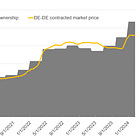Demand for Transportation in Europe, Increases on the horizon?
The last component preventing European transportation prices from increasing
Demand for transportation is currently the most influential factor in the European road freight market. While other periods have seen cost increases, capacity supply, or governmental interventions primarily driving transport prices, I see this time demand to significantly shape the near future market development. Besides, other ingredients, such as available capacity and cost pressure (due to high production cost increases and insufficient transport price adjustments), have the potential to spice up the soup.
This sets the stage for a new period of the freight market, although the industry waits for signs to start this new era. But there is also the possibility that this turns out like a chase of a mirage as most economic institutes and governmental bodies continue to revise down their growth projections for the current year.
This uncertainty offers a hidden advantage for shippers, as low transport rates can lead to cost savings amidst economic challenges. Conversely, carriers face challenges from production cost increases, reduced utilization, and tense competition despite high investments in more environmentally friendly transport solutions.
It's worthwhile to delve into the demand for transportation, explore how it can be measured, and how we can derive data-driven conclusions and expectations from it.
The following chart compares the demand for transportation index, which we calculate and measure based on transports executed on the Transporeon platform, with the HCOB Eurozone Manufacturing PMI, compiled by S&P Global. To enhance comparability with the PMI, we determined the seasonal component through Seasonal-Trend Decomposition using LOESS (STL) and subtracted it. This allows for more meaningful conclusions regarding a general trend and aligns better with PMI’s intent.
Since the PMI is inherently a forward-looking metric, we should ideally be able to see a correlation and predict trend changes for demand as they occur.
Comparison of European demand for transportation and Purchasing Manager Index
Source: HCOB Eurozone Manufacturing PMI by S&P Global and Transporeon transport execution, own illustration
The index value of 50 represents a neutral market situation for both, the demand for transportation and the PMI. It indicates that the demand for transportation is stable compared to the past three years’ monthly average, and in the case of the PMI, that expectations for the business development are on par with the previous month. Values above 50 signal a growing market, while values below 50 indicate a decline. I have highlighted a few periods to demonstrate their correlation and show when a change in trend occurs. It appears that a significant shift in the PMI becomes evident also in demand for transportation index after 3 to 7 months. With this in mind, we now can start considering:
What implications does this have for the transportation market in the coming weeks and months?
The PMI continues to indicate a clouded mood within the Eurozone's economies, but it bottomed out in late 2023 and has been rising in the past months. A closer look at the PMIs’ sub-indices and press release comments reveals a mixed picture. On one hand, countries like Spain and Italy show positive values (>50), while other major contributors to the index such as France and Germany, suppress the value. On the other hand, business expectations for the upcoming period increased, even though production, new orders and delivery times compared to past month reduced.
Based on these latest indifferent PMI figures, it's challenging to forecast a clear picture or trend for the upcoming months. However, transportation demand, which hit a low a few months after the PMI, is now showing slight increases to change the trend. A noticeable shift is seen in several industries: Paper & Print (+13,6%), Packaging (+7,3%) and Construction (+2,9%) have demonstrated an increase in the recent month compared to 2023, leading to more transports than before. On the other hand, industries like Automotive and Metal & Steel remain sluggish with lower need for transportation.
While there is no clear sign of significant increases soon, certain market segments show improvements compared to the previous year.
In my view, the coming weeks and months may see further increases in transportation demand. This could heighten the pressure on the spot market and subsequently lead to higher spot and contracted price levels compared to last year.
What’s your perspective? Do you anticipate further (small) demand increases, a steady situation, or even decreases? Please share your thoughts and vote in this poll below.
Christian Dolderer
Lead Research Analyst






